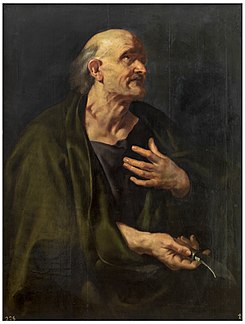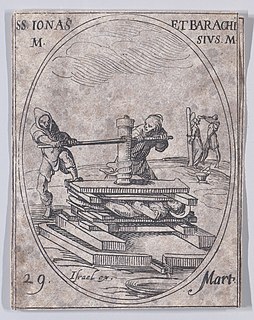
Bartholomew was one of the twelve apostles of Jesus according to the New Testament. He is said to have been martyred for having converted Polymius, King of Armenia, to Christianity. He has also been identified as Nathanael or Nathaniel, who appears in the Gospel of John when introduced to Jesus by Philip, although some modern commentators reject the identification of Nathanael with Bartholomew.

Denis of Paris was a 3rd-century Christian martyr and saint. According to his hagiographies, he was bishop of Paris in the third century and, together with his companions Rusticus and Eleutherius, was martyred for his faith by decapitation. Some accounts placed this during Domitian's persecution and identified St Denis of Paris with the Areopagite who was converted by Paul the Apostle and who served as the first bishop of Athens. Assuming Denis's historicity, it is now considered more likely that he suffered under the persecution of the emperor Decius shortly after AD 250.

April 8 - Eastern Orthodox liturgical calendar - April 10
Cyriacus, sometimes Anglicized as Cyriac, according to Christian tradition, is a Christian martyr who was killed in the Diocletianic Persecution. He is one of twenty-seven saints, most of them martyrs, who bear this name, of whom only seven are honoured by a specific mention of their names in the Roman Martyrology.

June 16 - Eastern Orthodox Church calendar - June 18

Saint Anastasius of Persia, was originally a Zoroastrian soldier in the Sasanian army. He later became a convert to Christianity and was martyred in 628.
Elias and four companions, Daniel, Isaiah, Jeremiah, and Samuel were Egyptian martyrs. Their feast day is February 16.
Zanitas and Lazarus of Persia were martyrs of the Christian church.
Acepsimas of Hnaita was a bishop, martyr and saint.
Basilides and Potamiaena were Christian martyrs now venerated as saints. Both died in Alexandria during the persecutions under Septimus Severus.
Shahdost was Bishop of Seleucia-Ctesiphon and primate of the Church of the East from 341 to 343. He was martyred during the great persecution of Shapur II. Like several other early bishops of Seleucia-Ctesiphon, he is included in the traditional list of patriarchs of the Church of the East. He is considered a saint in some quarters.

October 12 - Eastern Orthodox liturgical calendar - October 14

November 19 - Eastern Orthodox liturgical calendar - November 21
Saint Barsabias was an abbot and missionary who was martyred in Persia. His feast day is 20 October.

The Martyrs of Persia under Shapur II were Christian martyrs who were put to death by Shapur II of Persia for failing to renounce their faith. There may have been several thousand in total. They are remembered as a group in the Roman and Orthodox calendars. The Roman Martyrology gives feast days of 6 April, 22 April and 9 May for different groups.
Saint Droctoveus was a Frankish abbot, the first abbot of what became Saint Germain-des-Pres in Paris.

Saints Jonas and Barachisius, two brothers, were Persian martyrs during the persecutions of King Shapur II.

The Martyrs of Carthage under Valerian were a group of Christians including Montanus, Lucius, Flavian, Julian, Victoricus, Primolus, Rhenus, and Donatian who were executed during the persecutions of the Roman Emperor Valerian in 259 AD. Their feast day is 24 February.
Saints Sapor, Isaac, Mahanes, Abraham, and Simeon were a group of Christians in Persia who were martyred under King Shapur II. Their feast day is 30 November.
Saints Daniel and Verda were Christian martyrs under King Shapur II of Persia. Their feast day is 21 February.







